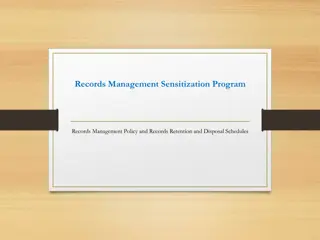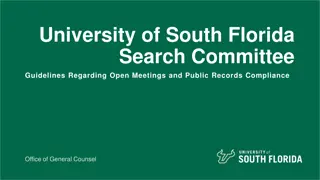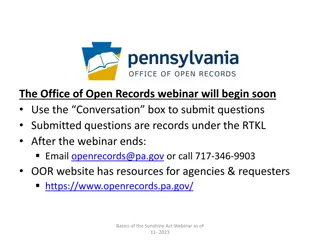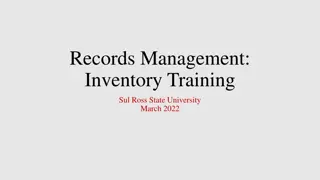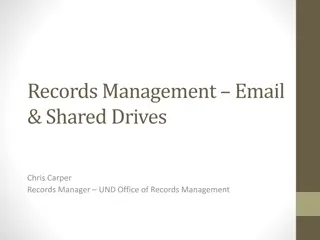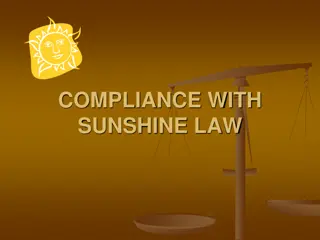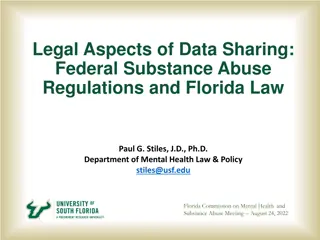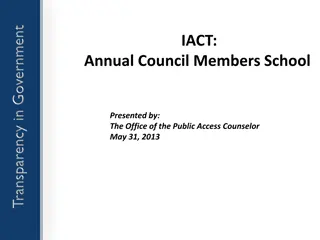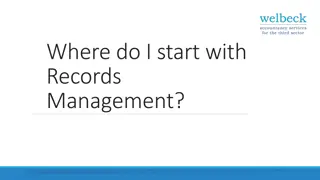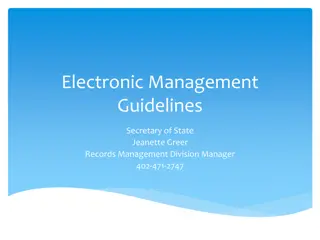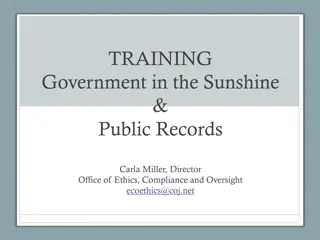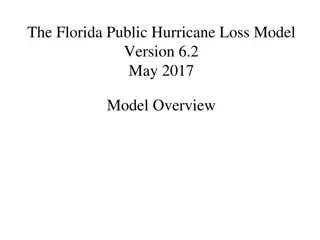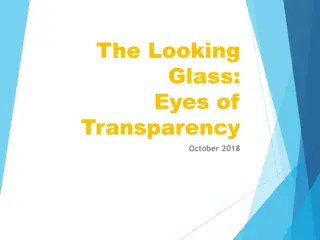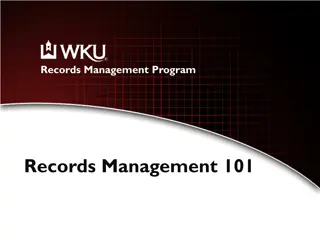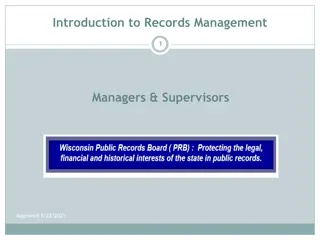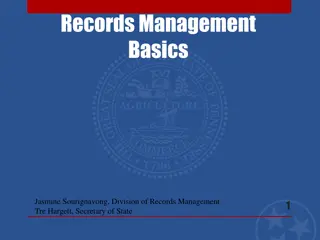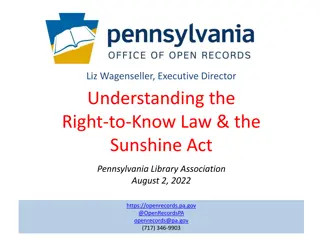Florida Sunshine Law Overview - Understanding Open Meetings and Public Records
The Florida Sunshine Law, passed in 1967, ensures openness in government by requiring collegial bodies to hold meetings accessible to the public, provide notice of meetings, and keep minutes. It applies to commissions, advisory boards, and committees but not meetings of employees unless serving as appointed committees. The law mandates transparency in discussions and decision-making processes of official business.
Download Presentation

Please find below an Image/Link to download the presentation.
The content on the website is provided AS IS for your information and personal use only. It may not be sold, licensed, or shared on other websites without obtaining consent from the author. Download presentation by click this link. If you encounter any issues during the download, it is possible that the publisher has removed the file from their server.
E N D
Presentation Transcript
Blood Clot and Pulmonary Embolism Policy (BCPEP) February 21, 2024 ( T h i s m e e t i n g i s b e i n g r e c o r d e d )
In 1967, the Florida Legislature passed the Government-in-the-Sunshine law, which became the nation s first open meetings law. It was codified at Chapter 286, Florida Statutes. In 1992, Florida voters approved a proposed constitutional guaranteeing Florida citizens a right of access to public records and meetings. It became Article I, Section 24 of the Florida state constitution. The History of Florida s Sunshine Law amendment
The Sunshine Law governs the actions of members of a collegial body. A collegial body commissions, advisory boards, ad hoc committees, or task forces. AHCA is not a collegial body, so meetings of its employees are not subject to the Sunshine Law UNLESS the employees are meeting as an appointed committees. Additionally, collegial bodies formed solely for the purpose of fact-finding are not subject to the Sunshine Law. would include Who Does the Sunshine Law Apply To?
There are 3 basic requirements under the Sunshine Law: A collegial body s meetings must be open to the public; A collegial body must give the public reasonable notice of its meetings; and A collegial body must keep minutes of its meetings. What Are the Requirements of the Sunshine Law?
A meeting of a body subject to the Sunshine Law is broadly defined to include any gathering formal or informal during which two or more members of the body discuss the official business of the body. Accordingly, business-related discussions between members of the collegial body may only take place at open, properly- noticed meetings. Members may not discuss the business of the collegial body with each other through private phone conversations or e-mail discussions. Members may distribute documents to each other, but they may not discuss or exchange comments on those documents outside of a public meeting. Members may also discuss business with third parties (i.e., non-members of the body), provided the members do not use a third party as a liaison for business-related communication with other members. What Constitutes a Meeting Under the Sunshine Law?
The requirements for notice of public meetings are found in section 120.525, Florida Statutes. These requirements are more specific than those of the Sunshine Law and dictate the following: Notice of public meetings, hearings, and workshops shall be by publication in the Florida Administrative Register not less than 7 days before the event. The notice shall include a statement of the general subject matter to be considered. An agenda shall be prepared in time to ensure that a copy of the agenda may be received at least 7 days before the event by any person in the state who requests a copy and who pays the reasonable cost of the copy. The agenda shall contain the items to be considered in order of presentation. After the agenda has been made available, a change shall be made only for good cause, as determined by the person designated to preside, and stated in the record. Notification of such change shall be at the earliest practicable time. Giving Notice of Public Meetings
Members of the public must be given a reasonable opportunity to be heard on a proposition before a state board or commission. The board may adopt policies governing this opportunity. This requirement may be enforced by injunction, and a court may award attorneys fees to the complainant. Public Participation
Although the Sunshine Law requires the collegial body to record minutes of its meetings, such minutes need not be verbatim transcripts of the proceedings. A summary or notes of the meeting is sufficient. It is within the collegial body s discretion to determine who is responsible for creating the minutes of meetings. Minutes of Meetings
As a general matter, any documents or other materials that are (1) created or received by collegial body members, (2) related to the collegial body s official business are public records which must be made available to the public for inspection and copying. Examples of public records made or received by collegial body members relating to their official business include reports, correspondence (including email and texts), and personal notes. Any confidential information made or received by a collegial body would retain its statutory exemption from disclosure as a public record. Collegial body members should also take care during the public meetings not to discuss information derived from such confidential records. Sunshine Law and Public Records
Overview on Venous Thromboembolic (VTE) Disease February 21, 2024
Overview When blood clots develop in the legs, they are termed deep vein thrombosis (DVT) Symptoms: leg swelling, pain, redness, tenderness to touch When a blood clot from a DVT breaks off and travels to the lungs, this results in pulmonary embolism (PE) Symptoms: shortness of breath, chest pain, high heart rate, low oxygen, cardiac arrest The spectrum of DVT and PE together are known as venous thromboembolism (VTE). These require immediate recognition and treatment 19 19
Extent of the problem 900,000 people affected by VTE annually in the US 60,000 1,000,000 people die each year from VTE VTE may account for 25% of sudden deaths Accounts for 1 in 10 in-hospital deaths Leading case of maternal death during and after pregnancy 33% of affected individuals have long-term complications and will have a recurrence within 10 years 20 20 www.cdc.gov/ncbddd/dvt/
Risk Factors for VTE Include: Advancing Age History of VTE Surgery or Trauma Within Last 4 Months Hospitalization or Nursing Home Stay Spinal Cord Injury or Paralysis of the Leg Active Cancer Obesity Venous Catheters or devices Chronic Medical Conditions Pregnancy and Postpartum Period Hormonal Therapy Use (i.e. estrogen contraceptives) Inherited Thrombophilia Disorder 21 21
Assessing patients risk for developing VTE 1. Identify those who may be at risk of blood clots and their need for anticoagulation prophylaxis 2. Risk assessment of admitted patients can be calculated by different scoring systems: Padua Predication Score (PPS) or Geneva Risk Score for VTE for medical patients Caprini Risk Assessment Model (CRAM) for surgical patients 22 22
Treatment Algorithm of patients with VTE Early identification and treatment is crucial Ultrasound is used to evaluate DVTs in extremities Computed Tomography (CT) pulmonary angiography of the lungs is used to detect Pes Based on clinical stability and other parameters, patient are risk stratified to determine best course of treatment Some centers have developed PE response teams (PERT) that are activated to rapidly treat these patients 23 23
Follow-Up of VTE Important for adequate follow-up of VTE patients: Evaluate cost and access to therapy Evaluate bleeding side effects and drug-drug interactions Determine duration of treatment Evaluate for chronic complications of VTE: Post-thrombotic syndrome from DVTs Chronic shortness of breath Chronic thromboembolic pulmonary hypertension (CTEPH) 24 24
Structured Surveillance System Currently there is no structured VTE surveillance in the US Developing a surveillance system includes specifying objectives: Describe the burden of disease Identify risk factors Evaluate impact on the population of prevention and treatment strategies Detect changes in healthcare practice and impact on the burden of disease Identify research needs 25 25 www.cdc.gov/
Important Steps for Surveillance Developing a case definition Identifying indicators and data sources (FloridaOne, FL DOH, AHCA) Field testing, Collecting and analyzing data Disseminating data findings Evaluating the system and its impact on the health problem 26 26 Am J Prev Med. 2010 Apr;38(4 Suppl):S502-9
Areas of Need Structured surveillance system and reporting of DVT/PE Identify and support/build expert treatment centers for VTE that have PERT teams and specific Pulmonary Vascular Programs Increase healthcare system compliance with identifying those at risk and VTE prophylaxis Increase population education on VTE for self-advocacy Better access to care and medications for those with acute VTE and chronic PEs Support to increase CTEPH treatment centers care in Florida Identify research opportunities in the space 27 27


